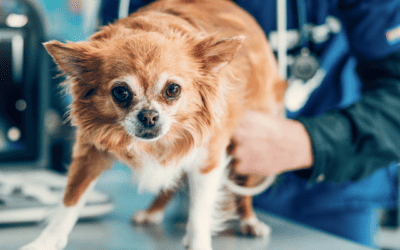It’s completely natural to feel hesitant about putting your reactive dog on long-term pain relief. As owners, we worry about side effects and the idea of lifelong treatment. We want the best for them, and medication often feels like a serious step. However, when it comes to behaviour, ignoring pain isn’t an option—it’s often the silent, underlying cause of problems we see every day.

The Subtle Link Between Discomfort and Difficult Behaviour
Think about how you act when you’re in chronic, low-grade pain—like a recurring backache or a throbbing knee. You might be more irritable, less patient, and prone to snapping or avoiding activities you usually enjoy. You’d likely take medication prescribed by your doctor to manage that pain so you can function.
Why should we expect our dogs to suffer in silence? They can’t tell us, “My hip hurts today,” so they communicate their discomfort through changes in their behaviour.
The Vicious Cycle: When Pain Drives Reactivity
When a dog is experiencing pain, even subtly, it can directly contribute to difficult behaviours. This is especially true for the reactive dogs and former street dogs we work with:
“Keep Away” Reactivity: A dog who snaps, lunges, or barks when approached might be trying to say, “Don’t touch me!” because movement or contact is causing them pain. Their reactive display becomes a highly effective way to create space and avoid discomfort.
Reduced Resilience: Pain reduces a dog’s threshold for stress. They may become more scared, shy, or nervous because they lack the physical comfort needed to cope with everyday sights and sounds in Edinburgh.
Lack of Focus: If your dog is distracted by internal discomfort, they physically cannot focus on your training cues or listen to you.
By avoiding pain relief when it is indicated, we risk leaving our dogs in a cycle of chronic distress and poor behaviour. This causes stress and anxiety for you, too, making you feel judged by the general public.
How Pain Relief is a Powerful Behavioural Tool
Pain medication, when properly managed by your vet, is not a ‘weak’ solution or a final resort; it’s a powerful tool that enables successful behaviour work.
- Reduces the Root Cause: It removes the primary physical irritant. Once the pain is managed, the associated behaviour often significantly improves because the dog no longer needs to use aggression or avoidance to cope.’
- Opens the Door to Learning: A dog whose body isn’t screaming in discomfort is much more able to process, learn, and implement the new coping skills we teach in our 1:1 sessions. This allows us to put management and a behaviour plan into place that actually works.
- Improves Quality of Life: The ultimate goal of your life together is for your dog to be happy, relaxed, and comfortable with everyday life, being a part of everything from cafe visits to walking The Munro’s. Addressing pain with medication allows your dog to experience that life fully, reducing their anxiety and stress, and allowing you to enjoy your dog fully
.
Remember, ensuring your dog is in good optimum health is the foundation of good behaviour. Our job at Edinburgh Holistic Dogs is to provide you with the bespoke training plans and emotional support that transforms your dog into a confident companion, giving you the confidence to enjoy life together.
I have seen many dogs behaviour turn around, by the addition of suitable pain relief and in turn getting the right medical care in place.
Its also worth remembering using pain relief doesn’t have to be long term, its a step towards uncovering what is really going on for your dog.
If you suspect pain is playing a part in your dog’s behaviour, the first step is always a consultation with your vet. Part our one to one work, is also providing your dog with a functional movement assessment, to help identify areas of discomfort or pain.
To learn more email contact@edinburghholisticdogs.co.uk or book a FREE call here.





